A novel specimen shape for measurement of linear strain fields by means of digital image correlation
- PMID: 34471200
- PMCID: PMC8410939
- DOI: 10.1038/s41598-021-97085-x
A novel specimen shape for measurement of linear strain fields by means of digital image correlation
Abstract
Strains on the surface of engineering structures or biological tissues are non-homogeneous. These strain fields can be captured by means of Digital Image Correlation (DIC). However, DIC strain field measurements are prone to noise and filtering of these fields influences measured strain gradients. This study aims to design a novel tensile test specimen showing two linear gradients, to measure full-field linear strain measurements on the surface of test specimens, and to investigate the accuracy of DIC strain measurements globally (full-field) and locally (strain gauges' positions), with and without filtering of the DIC strain fields. Three materials were employed for this study: aluminium, polymer, and bovine bone. Normalized strain gradients were introduced that are load independent and evaluated at two local positions showing 3.6 and 6.9% strain change per mm. Such levels are typically found in human bones. At these two positions, two strain gauges were applied to check the experimental strain magnitudes. A third strain gauge was applied to measure the strain in a neutral position showing no gradient. The accuracy of the DIC field measurement was evaluated at two deformation stages (at [Formula: see text] 500 and 1750 μstrain) using the root mean square error (RMSE). The RMSE over the two linear strain fields was less than 500 μstrain for both deformation stages and all materials. Gaussian low-pass filter (LPF) reduced the DIC noise between 25% and 64% on average. As well, filtering improved the accuracy of the local normalized strain gradients measurements with relative difference less than 20% and 12% for the high- and low-gradient, respectively. In summary, a novel specimen shape and methodological approach are presented which are useful for evaluating and improving the accuracy of the DIC measurement where non-homogeneous strain fields are expected such as on bone tissue due to their hierarchical structure.
© 2021. The Author(s).
Conflict of interest statement
The authors declare no competing interests.
Figures

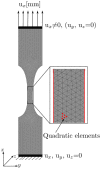
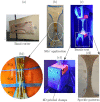

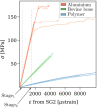

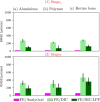

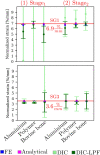
References
-
- Avril S, Pierron F, Sutton MA, Yan J. Identification of elasto-visco-plastic parameters and characterization of lüders behavior using digital image correlation and the virtual fields method. Mech. Mater. 2008;40:729–742. doi: 10.1016/j.mechmat.2008.03.007. - DOI
-
- Versaillot PD, Wu Y-F, Zhao Z-L. Experimental study on the evolution of necking zones of metallic materials. Int. J. Mech. Sci. 2021;189:106002. doi: 10.1016/j.ijmecsci.2020.106002. - DOI
-
- Xu Z, Peng L, Jain MK, Anderson D, Carsley J. Local and global tensile deformation behavior of aa7075 sheet material at 673ok and different strain rates. Int. J. Mech. Sci. 2021;195:106241. doi: 10.1016/j.ijmecsci.2020.106241. - DOI
-
- Lecompte D, Bossuyt S, Cooreman S, Sol H, Vantomme J. Study and generation of optimal speckle patterns for DIC. Proc. Annu. Conf. Exposit. Exp. Appl. Mech. 2007;3:1643–1649.
Publication types
LinkOut - more resources
Full Text Sources
Research Materials

